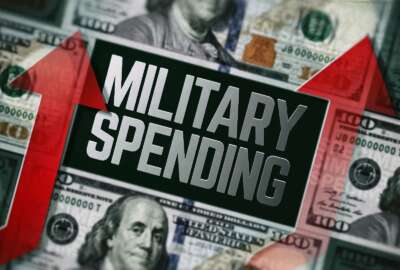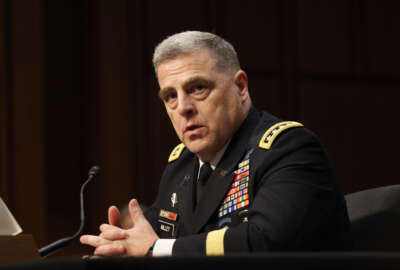
Readiness trumps buildup in new defense budget
The Defense Department is requesting $575 billion in its base budget, a $52 billion increase from last year to help increase readiness.
The big word in the President’s 2018 defense budget request is readiness and it doesn’t seem like it’s going away anytime soon.
The nearly $575 billion (nearly $640 billion with war spending built in) proposed budget is billed by Defense Department and military officials as the first step in a long road to get the military back in fighting shape for a near peer adversary.
But it falls far short of the big buildup talk President Donald Trump used on the campaign trail.
The 2018 budget, which requests $52 billion more in base funding than the 2017 budget, funds distinct readiness plans for each military service.
The Air Force will rebuild its home station high end training, the Army will focus on modernization, the Marine Corps will emphasize near-term readiness for deployments and the Navy will reduce its maintenance backlog with the extra potential money in the budget. Those are all areas where the services are hurting the most.
The 2018 defense budget request builds on readiness improvements made through the 2017 budget, said John Roth, who is performing the duties of the DoD comptroller during a May 23 press briefing at the Pentagon.
The 2017 budget clocked in at $523 billion, but was given $85 billion extra in emergency war funding to deal with dire readiness issues.
The budget for “2017 was about addressing immediate warfighting readiness, in [20]18 we want to continue to build a baseline from which to move forward from regarding readiness and so you see continued significant investment in aspects of unit preparedness: training, maintenance and modernization to restore warfighting readiness while setting the conditions for future sustained, comprehensive readiness,” said Lt. Gen. Anthony Ierardi, director of force structure, resources and assessment for the Joint Staff.
Roth added that 2019 will be used to sustain the gains made in 2017 and 2018.
At the beginning of the year the military service chiefs pleaded with Congress to fill readiness gaps caused by an environment of repeated continuing resolutions and some budget cuts.
“This is a long war we’ve been in, we’ve got emerging and reemerging threats that have all raised the stakes on making this long game even longer and we are not going to stay healthy if we don’t pay attention to our maintenance accounts,” Vice Chief of Naval Operations Adm. William Moran said. The “274 [ships], that 308 or that 350 is not going to be the same number at readiness funding levels that we have today.”
Army Chief of Staff Mark Milley gave a similar warning.
“Readiness will remain the number one priority,” Milley said. “If we’ve got some significant increase in money we will continue to prioritize readiness. Having said that, we have got to get after modernization, so there’s going to be a balance between the two.”
He added that adding soldiers to the force would be moot if readiness issues could not be addressed.
The budget seems fairly modest considering Trump’s campaign rhetoric, which at times called for a $100 billion increase in funding, increasing the Army’s active duty size to 540,000 and increasing the Navy’s fleet to 355 ships.
The active duty and fleet increase goals could still be in the works. Roth said rebuilding readiness is a multiyear effort. The budget does fund the Army to stay at its current active duty level of 476,000, that’s 26,000 more than the planned drop to 450,000. That will cost close to $2.5 billion per year to accomplish.
Roth said the Navy is still on track to reach 355 ships, but the timeline had not shortened.
Why stop at $575 billion?
The administration’s first goal seems to be to fill readiness gaps before it builds the force.
Still, Army Budget Director Maj. Gen. Thomas Horlander said more money could help with the Army’s readiness issues.
“More money could do better for us, however … it’s not just money, it’s time,” Horlander said. “Readiness is very much an accumulative dynamic, what we need more than anything else is to have the consistent funding from year to year at a level that is consistent to what we are trying to achieve.”
The budget request is already well above the sequestration cap levels for 2018. Congress will have to either repeal sequestration or come to another budget deal in order to meet the President’s request.
That could make the stability Horlander is hoping for seem like a long shot.
Still, if Congress has to extend the caps, why not shoot for a higher budget? Both Armed Services Committee Chairmen Sen. John McCain (R-Ariz.) and Rep. Mac Thornberry (R-Texas) support a base budget of at least $640 billion.
“It’s a bit of a judgmental thing. There’s not a point total that someone can point to and say ‘That’s the perfect number,’” Roth said. “We asked in [20]17 for what we thought was politically palatable, and as you’re aware we didn’t get everything in [20]17 that we asked for, but we got a healthy increase and we’re frankly very pleased and grateful for what the Hill provided … So in a similar fashion, we are asking for any increase. I mean $52 billion I would argue is not chump change.”
The future
Despite asking for more money for this year, DoD isn’t sure where it’s going funding-wise in the coming years.
“The [defense] secretary has not spent any time at all looking at anything beyond 2018 to date in large part because we have begun the process of developing the new defense strategy and the intent and the goal was that that new defense strategy would inform anything beyond 2019,” Roth said.
DoD therefore did not provide future outlays of its budget.
Copyright © 2025 Federal News Network. All rights reserved. This website is not intended for users located within the European Economic Area.
Scott Maucione is a defense reporter for Federal News Network and reports on human capital, workforce and the Defense Department at-large.
Follow @smaucioneWFED





